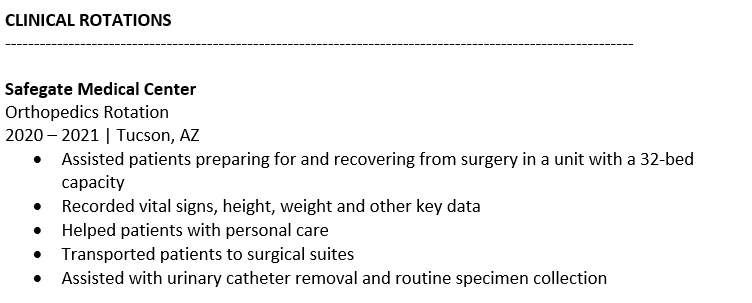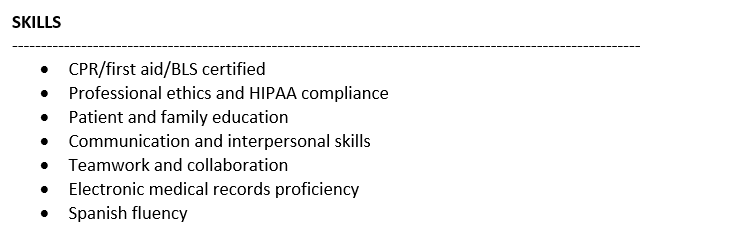Practical Tips for Building Your Nursing Student Resume

As of September 2021, the U.S. Bureau of Labor Statistics Occupational Outlook Handbook estimates job growth for registered nurses to increase by about 9% from 2020 to 2030, accounting for an estimated increase of 276,800 jobs in the field.1 This reflects a continuing trend of robust hiring prospects in the nursing field for the foreseeable future. But even though nurses are in high demand, it is still important to present yourself in the best possible light when you’re looking for a nursing job.
When you’re developing your nursing student resume, you should include all of your most impressive accomplishments, certifications, skills and professional recognitions. Because you haven’t yet graduated, you’ll have a nursing student resume with no professional experience as a full-time nurse. Nevertheless, you can still emphasize the experience you gained during your clinical rotations and similar learning experiences. Use the following practical tips as you work on your resume.
More on Nursing Student Resume Tips:
- Creating a Nursing Student Resume
- Your Letterhead
- Your Summary and Objective
- Your Nursing Degree
- Your Nursing Licensure and Certifications
- Your Clinical Rotations
- Your Work and Volunteer Experience
- Your Achievements, Awards and Affiliations
- Your Nursing Skills
- How To Bolster a Nursing Student Resume With No Experience
- Keeping Your Resume Current
Creating a Nursing Student Resume
As a rule of thumb, your resume should be no more than two pages, although a one-page resume is preferred by many employers. Try to display an aesthetically pleasing amount of white space (space without text) to make it easier on the eyes. Maintain consistent formatting throughout, such as by using bold type for all section titles, as well as for the names of schools and hospitals.
Avoid using pronouns (such as “I”) and don’t hesitate to use bullet points . However, even though bullet points are commonplace in a resume, be sure to proofread it carefully, as careless typos can cause an otherwise stellar resume to get rejected.
When listing your responsibilities or accomplishments, such as during your clinical rotations, try to use strong, actionable words. Some examples of good words to use are as follows:
- Assisted
- Communicated
- Counseled
- Created
- Developed
- Documented
- Improved
- Learned
- Recorded
- Researched
- Served
Now you’re ready to create your nursing student resume! This guide walks you through each section, step by step, and provides examples to emulate.
Your Letterhead
Your letterhead — at the very top of your resume — will contain your name and contact information. Include your phone number, email address and physical address. Your name should be in larger font than the rest of your resume.
If your current email address is not professional, you should create a new email specifically tailored to reflect your desired career in nursing. Use some variation of your name, such as your first initial and your last name: L.Garcia@example.com. If a variation of your name isn’t available, try including a digit or two.
Similarly, make sure your phone has a professional-sounding voicemail message. Record it in a room with no background noise and keep it simple. For example, say something like this: “Hi, this is Lilah Garcia. Please leave your name and number after the beep.”
Following your information, include a solid line to separate your letterhead from the rest of the resume. Here’s an example of what your letterhead should look like:

Your Summary and Objective
The summary and objective portion of a resume is optional. If you choose to include one, keep it brief, especially when you’re writing a nursing student resume with no professional experience. In fact, some career consultants recommend skipping the summary entirely when you have fewer than three years of experience and including only the objective.
If you do choose to include the summary before you’ve acquired full-time work experience, you should focus on your work ethic, skills and professional interests. Here’s an example of a summary for a nursing student with no work experience:

Note that this summary does not use complete sentences. You’ll also want to skip using pronouns in your resume. But despite the absence of complete sentences, you must still use punctuation (except for bulleted lists with incomplete sentences). Further along in your career, your summary is likely to get a little longer, with more concrete information in it.
Your objective, if you choose to include it, will go right beneath your summary. Alternatively, you could choose to include only an objective and skip the summary. Note that the objective should be written in the third person — and again, it will not be a complete sentence. Here’s an example:

Your Nursing Degree
Although you haven’t quite completed your nursing degree yet, you’ll still have a section on your resume labeled “EDUCATION.” List the full name of your school, its location, your expected graduation date, and your nursing degree. If your grade point average (GPA) is impressively high, you might also choose to include that. Here’s an example of what this will look like:

Note that the name of your school should be in bold. Similarly, you’ll also use bold font for every healthcare organization where you’ve completed clinical rotations and, later on in your career, for the organizations you’ve worked for as a full-time nurse. After you graduate, don’t forget to delete the word “expected” and leave your official graduation date. Also be sure to update your GPA if it changes.
Your Nursing Licensure and Certifications
Because you’re still a nursing student, you don’t yet have your nursing license. However, if you’ve scheduled your test date, you can include that information in a section labeled “LICENSE AND CERTIFICATIONS.” If you don’t yet have a test date for the NCLEX-RN, then just label this section “CERTIFICATIONS.”
List all certifications you hold, such as basic life support certifications. Here’s an example of what this section might look like on your nursing student resume:

If you have two or fewer items to list in this section, it may be best to combine this section with the achievements and awards section below. If you choose to do so, keep the list of your professional affiliations in its own section.
Your Clinical Rotations
Every time you do a clinical rotation, you should take notes about your start and end dates, the unit you were assigned to and what you accomplished there. This is the part of your resume where you’ll want to get specific about what you’ve done and learned. It’s an opportunity to demonstrate to potential employers that you are capable, competent and confident in a clinical environment.
Here’s a look at how a nursing student resume can demonstrate clinical experience. Note that you can label this section a few different ways, such as “CLINICAL EXPERIENCE,” “CLINICAL ROTATIONS” or “STUDENT CLINICAL EXPERIENCE.” There is really no right or wrong way to label it.

As a rule of thumb, you should list your rotations in order from most relevant to least relevant. For instance, if you’re applying for a position in a medical and surgical unit and you’ve previously completed a med-surg rotation, you should list that first, followed by any other rotations involving other patient populations.
Try to be as specific as possible. For instance, you can list how many beds were in a unit and how many hours each clinical rotation lasted, although this is optional.
Your Work and Volunteer Experience
At this point in your career, you may not have any relevant work experience or volunteer positions that you can list. If that’s the case, simply omit this section and try to expand upon your clinical rotations a bit more.
However, you may have some relevant experience to list. For example, you might have worked as a certified nurse assistant (CNA) before deciding to become an RN. Here’s a look at how this section might look:

Note that when describing these positions and roles, you can point to specific things that you learned. This is an effective way to demonstrate to potential employers that you value learning and professional growth.
Your Achievements, Awards and Affiliations
In this section, list all of your achievements, recognitions and relevant affiliations. You could even list nominations and academic scholarships you’ve received.
It’s acceptable to branch out a little and list an accomplishment that isn’t strictly related to nursing. For instance, you might mention that you were the captain of your college soccer team or the treasurer of your sorority. Such achievements demonstrate your leadership abilities and go-getter attitude. Here’s a look at how this section might look:

Your Nursing Skills
Nurses need to master many skills, ranging from wound care and first aid to CPR and medication administration. However, in the skills section, it’s important to avoid limiting yourself to nursing skills alone. True, potential employers will want to see skills listed here, but they are also interested in your soft skills, such as time management, patient communication and emotional intelligence.
Here’s a look at what your skills section might look like:

Try to avoid an excessively long list of skills — remember, you’ll want to limit your resume to just one or two pages at most. If necessary, you can split the skills section into two short columns to conserve space. Another strategy is to merge similar entries, such as by listing “teamwork and collaboration” on the same line.
How To Bolster a Nursing Student Resume With No Experience
It can be a little challenging to put together a nursing student resume with no experience, but your clinical rotations and other academic experiences should help you flesh out the document. Another way to bolster your nursing student resume is to plan on earning additional credentials after graduation and licensure. This demonstrates your commitment to lifelong learning and nursing excellence.
For instance, you might enroll in a relevant graduate certificate program at your university. Unlike nursing degrees that require clinical, hands-on learning experiences, many graduate certificate programs can be completed entirely online. This gives you the flexibility needed to continue your academic journey while also looking for your first nursing job.
You can include your graduate certificate on your resume before you complete the program, but be sure to indicate that you haven’t yet earned the certificate. Include this entry in your “EDUCATION” section with the full name of the university, the certificate program and the expected completion date.
Keeping Your Resume Current
Even after you land a nursing job that you’re happy with, it’s important to keep your resume up to date. You might not be planning on applying for a different job any time soon, but if you regularly update your resume as soon as anything changes, you won’t find yourself frantically trying to remember important information later on. Update your resume as soon as any of the following events occur:
- You earn a new degree.
- You acquire a new license or certification.
- You receive a promotion.
- You receive a professional award or recognition.
- You join a new professional organization.
- You acquire new skills.
- You serve in a new volunteer position.
Of course, if you do transition to a new job, you’ll also want to update your resume with the completion date of your old position and the starting date of your new position.
Think carefully about how you’ll store your resume. A hard drive can be destroyed by a spilled beverage and flash drives can become corrupted. Consider saving your resume in cloud storage so you won’t have to worry about losing your important information.
When you become a nursing student at Grand Canyon University’s College of Nursing and Health Care Professions, you’ll benefit from rigorous instruction, immersive simulation learning experiences, approachable instructors and a full range of student support services — from resume assistance to interview preparation. After you graduate with your Bachelor of Science in Nursing, consider improving your career qualifications with a graduate certificate, such as the Graduate Certificate of Completion in Health Care Quality and Patient Safety. Click on Request Info at the top of your screen to explore your future at GCU.
1COVID-19 has adversely affected the global economy and data from 2020 may be atypical compared to prior years. The pandemic may impact the predicted future workforce outcomes indicated by the U.S. Bureau of Labor Statistics as well. Accordingly, data shown is based on September 2021, which can be found here: U.S. Bureau of Labor Statistics, Occupational Outlook Handbook, Registered Nurses.
Approved by the Dean of the College of Nursing and Health Care Professions on Oct. 24, 2022.
The views and opinions expressed in this article are those of the author’s and do not necessarily reflect the official policy or position of Grand Canyon University. Any sources cited were accurate as of the publish date.


